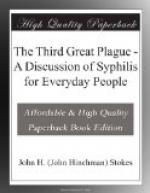an enormous resistance to the disease, which in a
measure compensates for the hold which it has on him.
Treatment in hereditary syphilis becomes an extremely
difficult problem because it must in many cases be
carried out during infancy, and for that reason the
cooeperation of the patient cannot be secured.
By treating the mother, we now know that we can accomplish
a great deal for the unborn child. Once the child
is born, its salvation will depend on unremitting
care and labor. If it is skilfully treated and
kept at the breast, it is estimated that it has even
as high as ninety chances in one hundred of surviving
to a useful life. Salvarsan can be given to even
very small babies, and mercury also is employed with
excellent results. Persistence and skill are
essential, and for that reason, if possible, hereditary
syphilis in active form in later childhood should
have the advantage of occasional or prolonged treatment
in special hospitals or sanitariums where the child
could go to school while he is being built up and
cared for. This is not like trying to salvage
wreckage. Many syphilitic children are brilliant,
and if treated before they are crippled by the disease,
give every sign of capacity and great usefulness to
the world. Welander, who was one of the greatest
of European experts on syphilis, has left himself
an enduring monument in the form of the so-called
Welander homes, which have been established by cities
like Copenhagen, Berlin, and Vienna to provide for
such children the combined benefits of the school
and the hospital. We cannot be too prompt in
adopting similar provision for such cases in this country.
There can be little excuse, eugenic or otherwise, for
not doing the utmost that modern medical science is
capable of for their benefit.
Chapter XI
The Transmission and Hygiene of Syphilis
The problem of the control of syphilis as a contagious
disease is the least appreciated and the most important
one in the whole field. It should be the key
to our whole attitude toward the disease, and once
given its rightful place in our minds, will revolutionize
our situation with regard to it. For that reason,
while some repetition of what has gone before may
be unavoidable, it will be worth while to gather in
one chapter the details relating to the question of
how the disease is spread about.
Two bed-rock facts stand out as the basis for the
whole discussion. First, for practical purposes
syphilis is contagious only in the primary and secondary
stages. Second, syphilis is transmitted only by
open sores or lesions whose discharges contain the
germs, or by objects which are contaminated by those
discharges. Infection with syphilis by such fluids
as the blood, milk, or spermatic fluid uncontaminated
by contact with active lesions is at least unusual.




